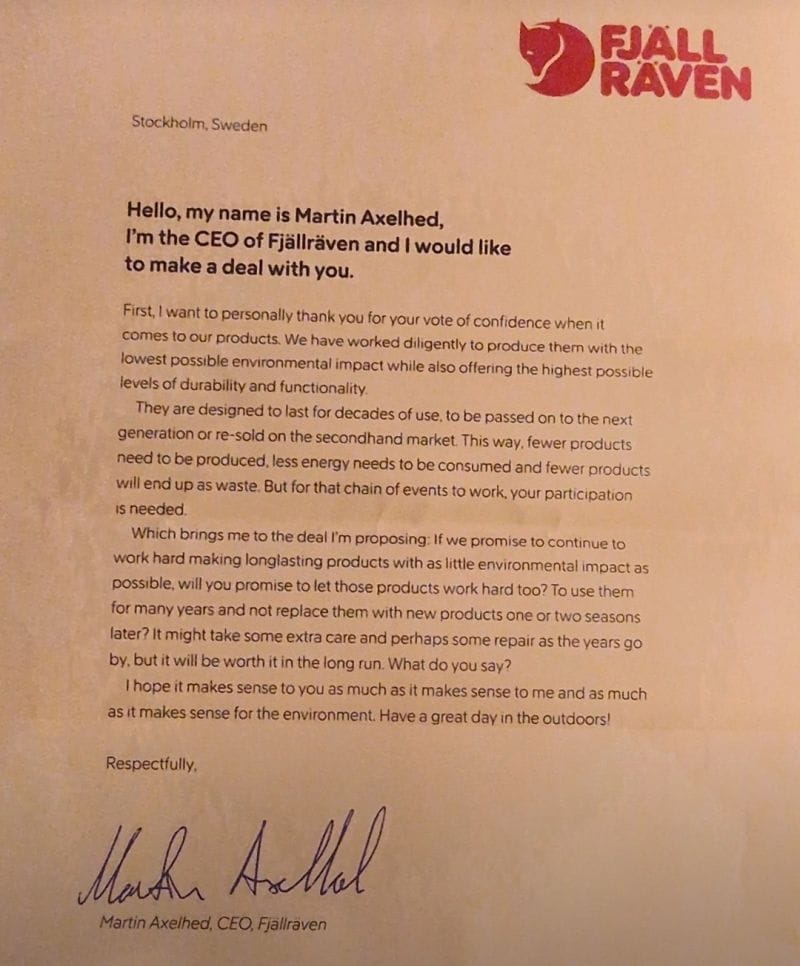Fjällräven CEO urges customers to keep their old stuff for longer
The Swedish brand's stunt is cute, but what are they actually trying to achieve?
Part of building a brand with people that love the outdoors these days involves making sure that your customer's love for your gear, doesn't destroy the place they love using it the most.
As we all know, making stuff from polyester, that gets dyed, wrapped on pallets in a giant plastic bag and shipped around the world on a ship - obviously comes at a cost to the environment. People that love looking at morning dew on leaves and identifying buck by the shape of their droppings don't necessarily want to buy a backpack that just murdered a turtle on the way to the shop.
Need to develop your strategic thinking practice?
Build your brand better in 2024 with our structured 12-week program of strategy development for you and your team.
Get in touch to discussBut if customers buy less stuff, less often - some of the pressure on the environment (at least in theory) is reduced.
Fjällräven's CEO, Martin Axelhed, recently announced that he will be personally sending this letter [the one below] to all customers who buy Fjällräven stuff as a gentle reminder to them to keep their new thing longer and try fix it rather than turf it once it succumbs to wear-and-tear.

The idea is that Fjällräven are at least fulfilling their part of the deal with the customer by designing and making stuff that's cool and will stay cool for some time to come (that's if they keep putting that adorably cute little red fox logo on their things).
But does this tactic do anything for the Fjällräven brand?
Look, if I've just spent a couple of thousand ZARs on a backpack with a little red fox on it, the last thing I really want is a lecture from a CEO who's living large in Stockholm, Sweden. That was obviously not the intention of the letter, but for some (who take the time and effort to read it) that may be what comes across.
Here's the problem though; unlike Patagonia (the poster child for doing sustainable outdoor right) - Fjällräven is a brand that is owned by Fenix Outdoor, a publicly-listed company in Europe. What shareholders want as long-term holders of Fenix Outdoor paper... is growth. Not shitty growth that's manufactured by cutting costs; customer growth, sales growth, brand growth...more stores, more regions, more trading volume, more profit, more dividends.
Telling customers to not buy another Fjällräven product too soon goes against what the marketing function of a flourishing, growth brand is all about. If you are purposefully lengthening the repurchase time horizon of your customer base, you are intentionally devaluing the worth of your customers that you have paid to acquire.
Perhaps the current brand growth, thanks to strong customer demand in new markets that the business is enjoying, will easily offset any negative financial outcomes from customers who actually take Martin Axelhed challenge to heart (a calculation those shrewd Swedes have done repeatedly just to make sure). But even given that calculation, it's not clear as to what advantage this move really gives Fjällräven.
The brand already has strong ESG credentials and at least some (probably just a small %) of the customers who buy Fjällräven do so because they care about the future of the planet a bit more than how cute they're going to look with the little cute fox emblazoned on their school backpack. But it's doubtful that this letter is going to have any kind of material positive impact on the future of the brand.
What the opportunity for Fjällräven?
Fjällräven will save the environment and grow their brand at the same time by taking more and more purchases away from the fast fashion category, which is where the real environmental problems lie. In reality people who love to shop at H&M will also love to own a Fjällräven product - what's needed is a strategy to redirect some of that enormous H&M, Shein, Cotton On spend Fjällräven's way. This little letter sent to online customers - or whatever bigger campaign it may be a part of - is not going to achieve that.
If kids are willing to spend R1000 on a silly sippy-cup, they'll make a plan to buy a R2500 backpack with a cute fox on it. The play for Fjällräven is to start thinking of themselves as more than an 'outdoor brand' that appeals to old guys with ear hair who proudly sport bruised toenails from wearing leather hiking boots for too long. Open up the public's mental access to the brand, choose shoot locations that aren't on a mountain, free your brand up just a bit.
Small brands don't don't change the world for the better, only big brands with serious clout can do that. What's needed here is a change in consumer buying behaviour - a mammoth task that brands with their intention in the right place like Fjällräven can achieve if their set their sights on the opportunity.
The recommendation then is...build it big and take the fight to H&M.

